Haier DW9-TFE3, DW9-UFE3 User Manual
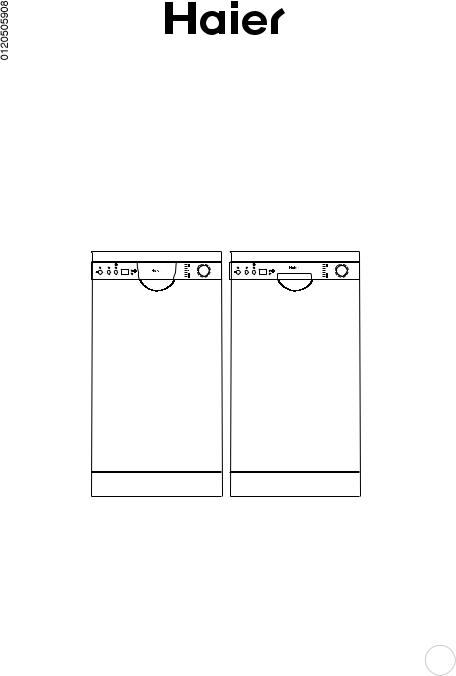
Dishwasher
DW9-TFE3 Series
DW9-UFE3 Series
Instructions for Use
en
Index |
en |
Safety information |
2 |
Installation |
4 |
Getting to know your dishwasher |
7 |
How to fill the salt |
8 |
How to fill rinse aid |
9 |
How to fill the detergent dispenser |
9 |
Not suitable for the dishwasher |
10 |
Arranging crockery, glasses, etc. in the dishwasher |
11 |
Programme overview |
13 |
Washing dishes |
15 |
How to keep your dishwasher in shape |
18 |
Care and maintenance |
19 |
Fault finding |
21 |
Technical data |
25 |
Important information |
25 |
1
Safety information |
en |
At time of delivery
Check packaging and dishwasher immediately for signs of transport damage. If the appliance is damaged, do not put it into use but contact your supplier or customer service without delay. Please dispose of packaging materials properly.
During installation
Site the dishwasher and connect it up in accordance with the installation instructions.
The dishwasher must not be connected to the electricity supply while installation is being carried out. Ensure that the domestic wiring is properly earthed.
The mains electricity supply must conform to the details shown on the dishwasher nameplate. Do not connect the dishwasher to the electricity supply via an extension cable.
Built-under and built-in appliances should always be installed under a continuous work surface which is attached to the adjacent cupboards, in order to ensure that the appliance is entirely stable.
After the appliance has been installed,the mains plug should still be easily accessible.
During installation, the power supply cord must not be excessively or dangerously bent or flattened.
During normal use
The dishwasher must only be used by adults for the washing of household dishes and cooking utensils. This appliance cannot be installed outdoor, not even if the area in which it is installed is covered by a roof; it is also very dangerous to leave it exposed to the rain and elements.
Do not place any heavy objects or stand on the door when it is open. The appliance could tip forward. The water inside the dishwasher is not suitable for drinking.
Do not use solvents of any kind inside your dishwasher. They could cause an explosion danger. Open the door very carefully if the dishwasher is operating. There is a risk of water squirting out. Do not touch the heating element during or after a wash cycle.
Fundamental rules to follow when using the appliance:
-Never touch the dishwasher when barefoot or with wet hands or feet;
-We discourage the use of extension cords and multiple sockets;
-If the appliance is not operating properly or maintenance must be performed, disconnect the appliance from the power supply.
2

en
If your family includes children
The appliance is not intended for use by young children or infirm persons without supervision. Young children should be supervised to ensure that they do not play with the appliance.
Keep detergents out of the reach of children, who must also be kept away from the dishwasher when it is open.
If a fault occurs
If the appliance malfunctions, turn off water supply to the appliance and disconnect the plug from the wall socket. Then, consult the section entitled, "Fault finding" .If you cannot solve the problem, contact a service center.
Only specialised personnel are authorised to make repairs.
If the supply cord is damaged, it must be replaced by the manufacture, its service agent of similarly qualified persons in order to avoid a hazard.
To maintain the EFFICIENCY and SAFETY of this appliance,we recommend:
-call only the Service Centers authorized by the manufacturer.
-always use original Spare Parts.
When disposing of old appliances
Appliances which are no longer being used must be made inoperable by cutting the power supply cord and removing the door lock.
Take the appliance to a designated waste disposal center.
Dangerous voltage
Warning
Children could get locked in the appliance (risk of suffocation) or get stuck in other positions. Therefore: Remove the mains plug, cut the mains wire and set aside. Damage the door lock so that the door can no longer be closed.
3
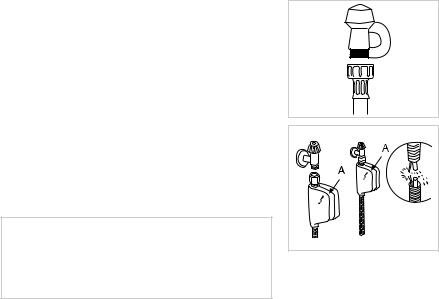
Installation |
en |
|
|
Positioning the appliance
Positioning the appliance in the desired location. The back should rest against the wall behind it, and the sides, along the adjacent cabinets or wall. The dishwasher is equipped with water supply and drain hoses that can be positioned to the right or the left to facilitate proper installation.
Levelling the appliance
Once the appliance is positioned, adjust the feet (screwing them in or out) to adjust the dishwasher, making it level. In any case, the appliance should not be inclined more than 2˚. If the appliance is level, it will help ensure proper performance.
Cold water connection
Connect the water supply hose to a threaded 3/4 (gas) connector, making sure that it is fastened tightly in place (see fig.A). Some models are fitted with an "Aquastop" water supply hose (see fig.B) in which the small filter is already housed in the threaded end.
If the water pipes are new or have not been used for an extended period of time, let the water run to make sure that the water is clear and free of impurities. If this precaution is not taken, there is a risk that the water inlet can get blocked and damage the appliance.
Warning
The appliance is to be connected to the water mains using new hose-sets and that old hose-sets should not be reused.
fig.A
fig.B
Anti-Flooding protection
The dishwasher is equipped with a system that stops the supply of water in the event of a problem with the water supply hose, or leaks within the unit, in order to prevent damage to your home. If for any reason the box containing the electrical components happens to get damaged, remove the plug for the appliance from the socket immediately. In order to guarantee that the anti-flooding feature operates properly, the "A" box with water supply hose must be attached to the water supply tap as shown in fig.B. No other type of connection is acceptable. The water supply hose must not, under any circumstances, be cut, as it contains electrical parts which are live. If the length of the hose is not adequate to make a proper connection, the hose must be replaced with one which is long enough. This hose is available upon request from specialised retailers and service center.
4
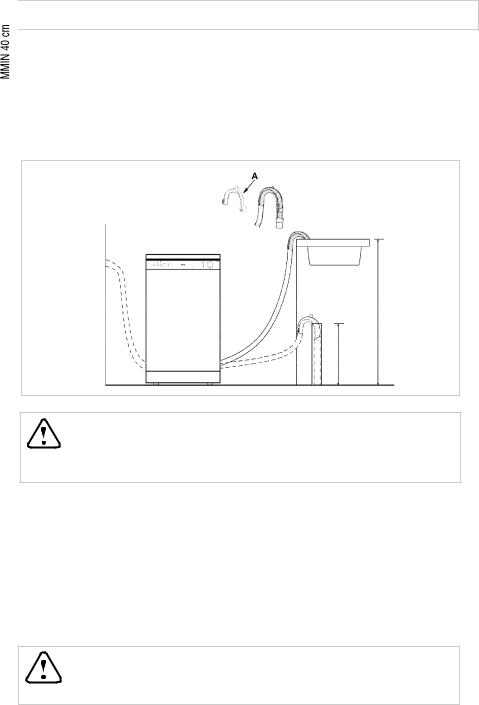
en
Drain hose connection
Insert the drain hose into a drain pipe with a minimum diameter of 4cm, or let it run into the sink, making sure to avoid bending or crimping it. If necessary, fit a syphon trap (U-bend) with a connecting piece for the drain hose (fig.C). The free end of the hose must be at a height between 40 and 100 cm and must not be immersed in water.
fig.C
Attention:
The connecting piece for syphon trap (U-bend) must be solidly fastened to the wall to prevent the drain hose from moving and allowing water to spill outside the drain.
Electrical Connection
After making sure that the voltage and frequency values for the current in the home correspond to those on the rating plate (located on the stainless steel inner door of the appliance) and that the electrical system is correct for the maximum voltage on the rating plate, insert the plug into an electrical socket which is earthed properly (the earthing of the appliance is a safety requirement mandated by law).
If the electrical socket to which the appliance must be connected is not appropriate for the plug, replace the whole cable, rather than using adaptors or the like as they could cause overheating and burns.
Caution:
The dishwasher plug must be accessible even when the appliance
is installed as a built-in unit so that maintenance can be done safely.
5

en
ELECTRICAL CONNECTION (UK ONLY)
For your safety please read the following information.
Warning: This appliance must be earthed.
The appliance must be connected to a 220-240 volts 50 cycle AC supply by means of a three pin socket, suitably earthed and should be protected by a 13 amp fuse in the plug or a 15 amp fuse in the consumer unit.
The appliance is supplied with a moulded 13 amp 3 pin mains plug fitted with a 13 amp fuse. Should the fuse require replacement, it must be replaced with a fuse rated at 13 amp and approved to BS1362. The plug contains a removable fuse cover that must be refitted when the fuse is replaced. In the event of the fuse cover being lost or damaged, the plug must not be used until a replacement cover has been obtained.
If the moulded mains plug is unsuitable for the socket outlet in your home or is removed for any other reason, then the fuse should be removed and the cut off plug disposed of safely to prevent the hazard of electric shock.
There is a danger of electric shock if the cut off plug is inserted into any 13 amp socket outlet.
Caution:
The dishwasher plug must be accessible even when the appliance is installed as a built-in unit so that maintence can be done safety.
6
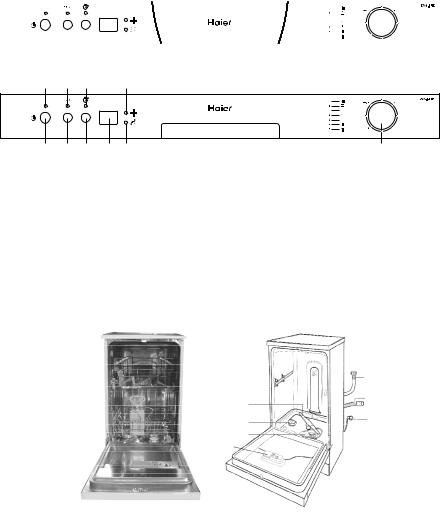
|
Getting to know your dishwasher |
|
|
en |
||||||
|
|
|
|
|
|
|
|
|
|
|
|
Close-up view (control panel) |
|
|
|
|
|||||
|
A C E |
H |
|
|
|
|
||||
|
|
|
|
|
|
|
|
|
|
|
|
|
|
|
|
|
|
|
|
|
|
|
|
|
|
|
|
|
|
|
|
|
|
|
|
|
|
|
|
|
|
|
|
|
|
|
|
|
|
|
|
|
|
|
|
|
|
|
|
|
|
|
|
|
|
|
|
|
|
|
|
|
|
|
|
|
|
|
|
|
|
|
|
|
|
|
|
|
|
|
|
|
|
|
|
|
|
|
B D F G I J
A C E H
B D F G I |
|
J |
A State Indicator |
F |
Delayed Start Button |
B ON-OFF Button |
G |
Time-remaining Indicator |
C "3 in 1" Indicator |
H |
Low Rinse Aid Indicator |
D "3 in 1" Button |
I |
Low Salt Indicator |
E Delayed Start Indicator |
J |
Knob For Selecting Cycle |
|
|
Dishwasher interior
a |
|
|
i |
c |
|
|
|
|
|
|
|
|
|
e |
j |
b |
d |
f |
k |
|
|||
|
|
g |
|
|
|
h |
|
a |
Upper Rack |
g |
Washing Filter |
b |
Lower Rack |
h |
Detergent and Rinse Aid Dispenser |
c |
Top Spray Arm |
i |
Water Inlet Hose |
d |
Silverware Basket |
j |
Drain Hose |
e |
Bottom Spray Arm |
k |
Power Supply Cord |
f |
Salt Container Cap |
|
|
7
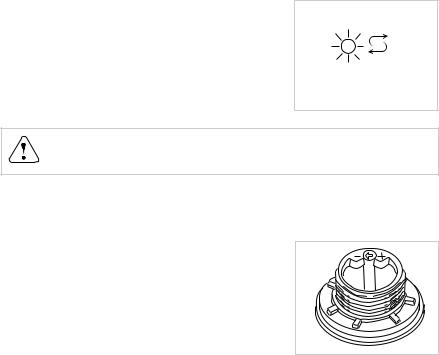
How to fill the salt |
en |
Salt
The hardness of the water varies from place to place. If hard water is used in the dishwasher, deposits will form on the dishes and utensils.
The appliance is equipped with a special softener that uses a salt specifically designed to eliminate lime and minerals from the water.
Loading the salt into the container
Always use salt intended for use with dishwashers.
The salt container is located beneath the lower rack and should be filled as follows:
When the low salt indicator “1” lights, you must fill the salt. |
|
|
Remove the lower rack and then unscrew and remove the cap |
|
|
from the salt container; |
|
|
If you are filling the container for the first time, fill it with water; |
|
|
Place the end of the funnel (supplied) into the hole and introduce |
|
|
about 2 kg of salt. It is normal for a small amount of water to |
|
|
come out of the salt container. |
1 |
|
Carefully screw the cap back on. |
||
|
Important
To prevent the formation of rust, load the salt just before beginning a wash cycle.
Adjusting salt consumption
The dishwasher is designed to allow for adjusting the amount of salt consumed based on the hardness of the water used. This is intended to optimize and customize the level of salt consumption so that it remains at a minimum.
To adjust salt consumption, proceed as follows:
Unscrew the cap from the salt container;
There is a ring on the container with an arrow on it (see figure to the side).
If necessary, rotate the ring in an anticlockwise direction from the "-" setting towards the "+" sign, based on the hardness of the water being used.
It is recommended that adjustments be made in accordance with the following table:
|
Water Hardness |
|
|
|
||
|
|
|
|
|
|
|
Level |
Clarke |
ºdH |
mmol/l |
Selector |
Salt |
Autonomy |
degrees |
position |
c o n s u m p t i o n |
(cycles/2kg) |
|||
|
|
|
(Grams/cycle) |
|||
1 |
0-14 |
0-17 |
0-1,7 |
/ |
0 |
/ |
2 |
14-36 |
18-44 |
1,8-4,4 |
"-" |
20 |
60 |
3 |
36-71 |
45-89 |
4,5-8,9 |
Middle |
40 |
40 |
4 |
>71 |
>89 |
>8,9 |
"+" |
60 |
25 |
|
|
|
|
|
|
|
8
